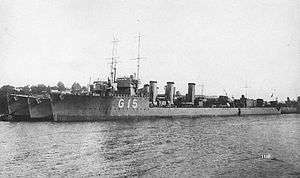HMS Rigorous (1916)
HMS Rigorous was an R-class destroyer which served with the Royal Navy during World War I. Launched on 30 September 1916, the vessel operated as part of the Grand Fleet, operating as part of destroyer flotillas hunting German ships that were attacking convoys. One flotilla was successful in destroying a Q ship in 1917. After the War, the destroyer was given a reduced complement and was sold to be broken up on 5 November 1926.
 Sistership HMS Romola | |
| History | |
|---|---|
| Name: | HMS Rigorous |
| Builder: | John Brown & Company, Clydebank |
| Yard number: | 452 |
| Laid down: | 22 September 1915 |
| Launched: | 30 September 1916 |
| Commissioned: | 30 November 1916 |
| Decommissioned: | 5 November 1926 |
| Fate: | Broken up |
| General characteristics | |
| Class and type: | R-class destroyer |
| Displacement: |
|
| Length: | 265 ft (80.8 m) p.p. |
| Beam: | 26 ft 9 in (8.15 m) |
| Draught: | 9 ft 10 in (3.00 m) |
| Propulsion: |
|
| Speed: | 36 knots (41.4 mph; 66.7 km/h) |
| Range: | 3,440 nmi (6,370 km) at 15 kn (28 km/h) |
| Complement: | 82 |
| Armament: |
|
Design and development
Rigorous was one of seventeen R-class destroyers ordered by the British Admiralty in July 1915 as part of the Sixth War Construction Programme.[1]
The destroyer was 265 feet (80.77 m) long between perpendiculars, with a beam of 26 feet 9 inches (8.15 m) and a draught of 9 feet 10 inches (3.00 m).[2] Displacement was 975 long tons (991 t) normal and 1,173 long tons (1,192 t) deep load.[3] Power was provided by three Yarrow boilers feeding two Brown-Curtis geared steam turbines rated at 27,000 shaft horsepower (20,000 kW) and driving two shafts, to give a design speed of 36 knots (67 km/h; 41 mph).[4] Three funnels were fitted. 296 long tons (301 t) of oil were carried, giving a design range of 3,450 nautical miles (6,390 km; 3,970 mi) at 15 knots (28 km/h; 17 mph).[4]
Armament consisted of three 4 in (100 mm) Mk IV QF guns on the ship's centreline, with one on the forecastle, one aft on a raised platform and one between the second and third funnels.[2] A single 2-pounder (40 mm) pom-pom anti-aircraft gun was carried, while torpedo armament consisted of two twin mounts for 21 in (533 mm) torpedoes. [4] Fire control included a single Dumaresq and a Vickers range clock.[5] The ship had a complement of 82 officers and ratings.[2]
Construction and career
Rigorous was laid down by John Brown & Company at Clydebank on the River Clyde in 22 September 1915 and launched in 30 September 1916, leaving the yard on 30 November that year. The destroyer was allocated the yard number 452.[6]
On commissioning, Rigorous joined the 15th Destroyer Flotilla of the Grand Fleet.[7] In October 1917, Rigorous formed part of a large-scale operation, involving 30 cruisers and 54 destroyers deployed in eight groups across the North Sea in an attempt to stop a suspected sortie by German naval forces. Rigorous, along with Rocket, Rowena, Sabrina and Trenchant, operated with the 2nd Light Cruiser Squadron.[8] Despite these measures, the German light cruisers Bremse and Brummer managed to attack the regular convoy between Norway and Britain on 17 October, sinking nine merchant ships and two destroyers, Mary Rose and Strongbow before returning safely to Germany.[9] The vessel was credited with bounty for sinking the German Q-ship K (also known as Kronprinz Willhelm) on 2 November 1917 along with Parker, Ready, Rocket, Rob Roy, Sorceress and Trenchant.[10] The ship was recommissioned with reduced complement on 30 October 1919.[11] Rigorous was decommissioned and broken up by Cashmore at Newport on 5 November 1926.[12]
Pennant numbers
| Pennant Number | Date |
|---|---|
| G90 | 1917[13] |
| G86 | 1918[13] |
References
Citations
- Friedman 2009, p. 310.
- Parkes & Prendegast 1919, p. 107.
- McCaid, John (2011). "Rigorous 1916 HMS – Destroyer". Clydemarine. Retrieved 15 April 2020.
- Gardiner & Gray 1985, p. 81.
- "Fire Control in H.M. Ships". The Technical History and Index: Alteration in Armaments of H.M. Ships during the War. 3 (23): 31. 1919.
- Johnston 2014, p. 198.
- "Destroyer Flotillas of the Grand Fleet". The Navy List: 12. January 1917. Retrieved 15 April 2020.
- Newbolt 1931, pp. 151.
- Newbolt 1931, pp. 153–157.
- "List of Prize and Salvage Awards". The Navy List: 2410. October 1920. Retrieved 15 April 2020.
- "Rigorous". The Navy List: 856. April 1920. Retrieved 15 April 2020.
- Colledge & Warlow 2010, p. 374.
- Dittmar & Colledge 1972, p. 69.
Bibliography
- Colledge, J. J.; Warlow, Ben (2010). Ships of the Royal Navy: The Complete Record of all Fighting Ships of the Royal Navy. Havertown: Casemate. ISBN 978-1-93514-907-1.CS1 maint: ref=harv (link)
- Dittmar, F.J.; Colledge, J.J. (1972). British Warships 1914–1919. Shepperton: Ian Allan. ISBN 978-0-71100-380-4.CS1 maint: ref=harv (link)
- Friedman, Norman (2009). British Destroyers: From Earliest Days to the Second World War. Barnsley: Seaforth Publishing. ISBN 978-1-84832-049-9.CS1 maint: ref=harv (link)
- Gardiner, Robert & Gray, Randal, eds. (1985). Conway's All The World's Fighting Ships 1906–1921. London: Conway Maritime Press. ISBN 978-0-85177-245-5.CS1 maint: ref=harv (link)
- Johnston, Ian (2014). A Shipyard at War: Unseen Photographs of John Brown & Co. Ltd, Clydebank, 1914-18. Barnsley: Seaforth Publishing. ISBN 978-1-84832-216-5.CS1 maint: ref=harv (link)
- Newbolt, Henry (1931). Naval Operations: Vol. V. History of the Great War. London: Longmans, Green and Co.CS1 maint: ref=harv (link)
- Parkes, Oscar; Prendegast, Maurice (1919). Jane’s Fighting Ships. London: Sampson Low, Marston & Co. Ltd.CS1 maint: ref=harv (link)